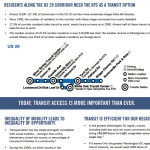Latest Happenings

Fact sheet: Benefits of Rapid Transit for Montgomery’s US-29 corridor
RESIDENTS ALONG THE US 29 CORRIDOR NEED THE RTS AS A TRANSIT OPTION
• Almost 9,500 (17.2%) of commuters in the US 29 corridor have commutes longer than 60 minutes.
• Since 1990, the number of residents in this corridor with these mega-commutes has nearly doubled.
• 17.5% of corridor residents take transit to work: nearly twice as many as in 1990. Almost half of these transit riders
take the bus to work

Prince George’s hospital plan approved by county, awaits key state clearance
It could be at least four years before a proposed regional hospital and medical campus opens at Largo Town Center, but the central Prince George’s community is already bracing for a development that could boost health-care options as well as the overall local economy. Officials hope it lives up to

As Part Of Multibillion-Dollar Package For Roads, Hogan Says ‘Yes’ To Purple Line
Maryland Governor Larry Hogan announced a major shift in state transportation spending to prioritize the maintenance and expansion of roads and bridges over investment in mass transit projects. While unveiling plans to spend $2 billion on roads — including $845 million on entirely new projects — at an Annapolis news

STATEMENT: Governor Hogan’s Purple Line announcement
ANNAPOLIS, MARYLAND -- Following Maryland Governor Larry Hogan's decision to move forward with the Purple Line, Coalition for Smarter Growth Executive Director Stewart Schwartz issued the following statement:

Maryland Gov. Larry Hogan’s decision is in on the Purple Line
Maryland Gov. Larry Hogan said Thursday the Purple Line will advance, but the two local counties that stand to benefit from the light rail line will be asked to shoulder a much larger burden. The alignment of the 16-mile Purple Line will not change, nor will the number of stations.
